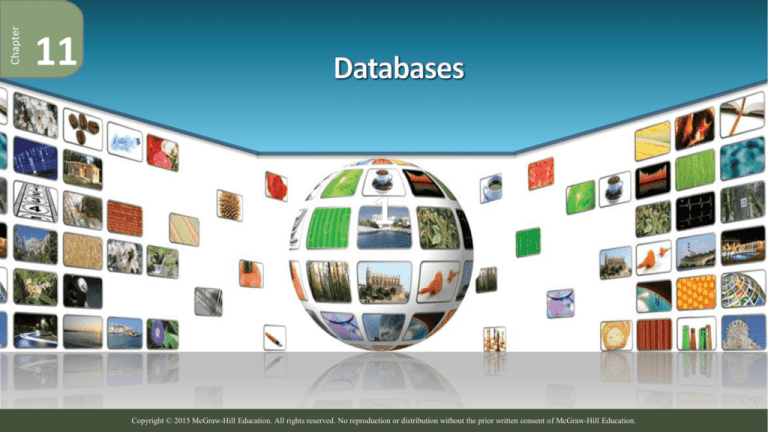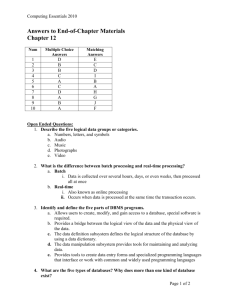
Chapter
11
Copyright © 2015 McGraw-Hill Education. All rights reserved. No reproduction or distribution without the prior written consent of McGraw-Hill Education.
Learning Objectives
1. Distinguish between the physical and logical views of data.
2. Describe how data is organized: characters, fields, records, tables, and
Computing Essentials 2015
3.
4.
5.
6.
7.
8.
databases.
Define key fields and how they are used to integrate data in a database.
Define and compare batch processing and real-time processing.
Describe databases, including the need for databases and database
management systems (DBMS).
Describe the five common database models: hierarchical, network, relational,
multidimensional, and object-oriented.
Distinguish among individual, company, distributed, and commercial
databases.
Describe strategic database uses and security concerns.
11-2
Introduction
• Like a library, secondary storage is designed to store
information
• End users need to understand
• How information is organized in fields, records, tables and
databases
• The different types of databases and structures
• Competent end users need to be able to find
Computing Essentials 2015
information that is stored in databases
11-3
Data
• Examples of data include
• Facts or observations about people, places, things, and events
• Audio, music, photographs, and video
• Two ways to view data
Computing Essentials 2015
• Physical view
• Logical view
11-4
Data Organization
Computing Essentials 2015
Logical view – data is
organized into groups or
categories
•
•
•
•
•
Character
Field
Record
Table
Database
Primary Key
• Unique identifier
11-5
Processing
• Batch processing
Computing Essentials 2015
• Data is collected over a period of time and the processing happens later all at one time
11-6
Processing (continued)
• Real-time processing
Computing Essentials 2015
• Also known as online processing because it happens immediately during the transaction
11-7
Database Advantages
• Collection of integrated data
• Logically related files and records
Computing Essentials 2015
• Databases address data redundancy
and data integrity
Advantages to having databases
• Sharing
• Security
• Less data redundancy
• Data integrity
11-8
Database Management
• Database Management
System (DBMS)
• DBMS engine
• Data definition
subsystem
Computing Essentials 2015
• Data dictionary / schema
Access data dictionary form
11-9
Database Management (continued)
• Data manipulation subsystem
• Data Maintenance
• Analysis Tools
• Query-by-example
• Structured query language (SQL)
Computing Essentials 2015
• Application generation
subsystem
• Data administration subsystem
• Database Administrators (DBAs)
• Processing rights
Access data entry form
11-10
DBMS Structure
• Database model
• DBMS programs work with data that is logically structured or arranged
• Model defined rules and standards for data in a database
Computing Essentials 2015
• Five common data models
•
•
•
•
•
Hierarchical database
Network database
Relational database
Multidimensional database
Object-oriented database
11-11
Hierarchical Database
• Fields or records structured in nodes
• Nodes
• points connected like
branches of an
upside-down tree
• One parent per node
• Parent can have
Computing Essentials 2015
several child nodes
• One-to-many relationship
Return
11-12
Network Database
• Hierarchical node arrangement
• Each child node may have more
than one parent node (many-tomany relationship)
• Pointers
Computing Essentials 2015
• Additional connections between
parent and child
• Nodes can be reached through
multiple paths
Return
11-13
Relational Database
• More flexible
• Data stored in table
Computing Essentials 2015
called a relation
• Tables consist of rows
and columns
• Tables related via a
common data item / key
field
Return
11-14
Multidimensional Database
• A variation and an extension of the relational model to include
additional dimensions, sometimes called a data cube
• Good for representing complex relationships
• Advantages over relational
Computing Essentials 2015
• Conceptualization
• Processing speed
Return
11-15
Object-Oriented Database
• Objects contain both
Computing Essentials 2015
data and instructions
• Organize using
• Objects
• Classes
• Attributes
• Methods
11-16
Types of Databases
Computing Essentials 2015
• Individual
• Integrated files used by just one person
• Company
• Common operational or commonly used files shared in an organization
• Distributed
• Database spread geographically and accessed using database server
• Commercial
• Information utilities
• Data banks available
11-17
Database Uses and Issues
• Strategic uses
• Data warehouse
• Data mining
• Security
Computing Essentials 2015
• Databases are valuable
• Protection necessary
Security: electronic
fingerprint scanner
11-18
Careers In IT
• Database administrators
• Determine the most efficient
ways to organize and access
a company’s data
• Responsible for database security
and backing up the system
Computing Essentials 2015
• Employers look for
• Bachelors degree in Computer Science
• Technical experience
• Database administrators can expect to
earn $67,000 to $98,000 annually
11-19
A Look to the Future ~ The Future of Crime Databases
• Can criminal behavior be
predicted ?
Computing Essentials 2015
• Research institutions have
been looking into patterns
that could predict criminal
behavior
• If patterns could be found .
. . Just need to find
individuals with these
characteristics
11-20
Open-Ended Questions (Page 1 of 2)
1. Describe the five logical data groups or categories.
Computing Essentials 2015
2. What is the difference between batch processing and real-time processing?
3. Identify and define the five parts of DBMS programs.
11-21
Open-Ended Questions (Page 2 of 2)
4. Describe each of the five common database models.
5. What are some of the benefits and limitations of databases? Why is
Computing Essentials 2015
security a concern?
11-22








